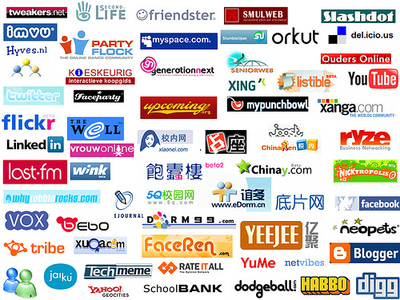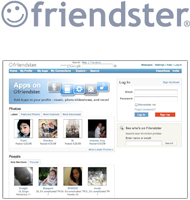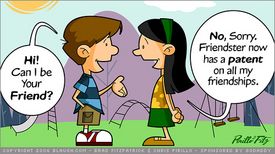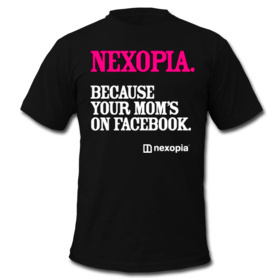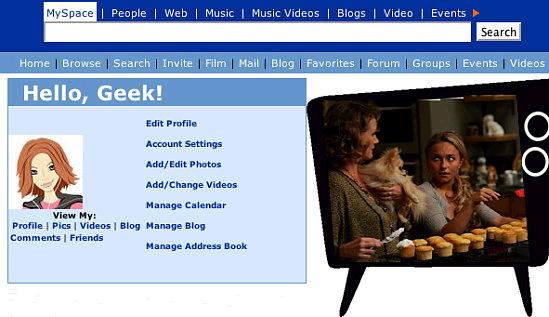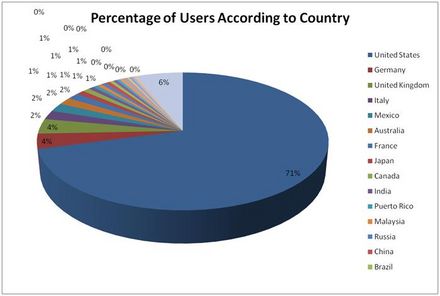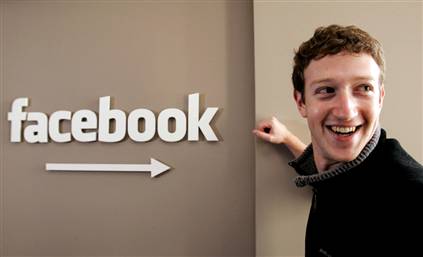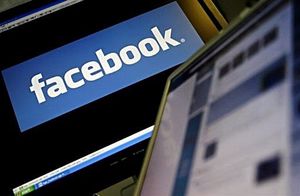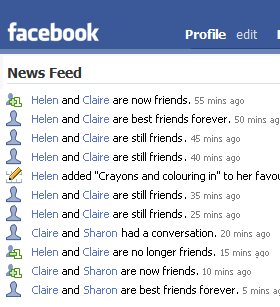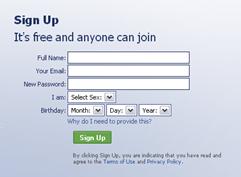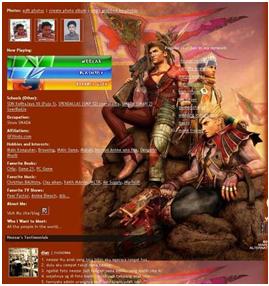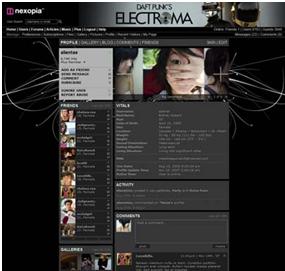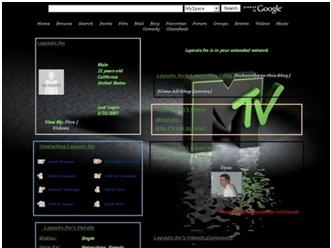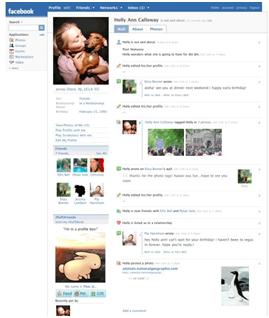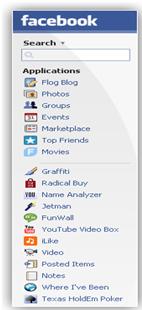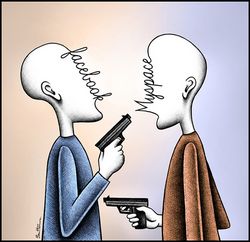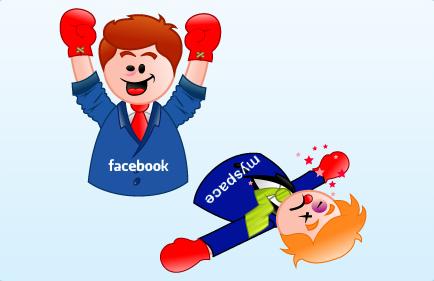The Virtual Race To The Top - Canadian Edition
Contents
Group Introduction
Group Number: 04
Members:
- Lily Lin
- Jeffrey Lu
- Misel Martinovic
- Melissa Rodrigues
- Usman Sajid
Lecture: Cpsc 203 Fa08 L01 Dr. Kawash
Tutorial T05 Aniket Mahanti
Project Introduction
Project Name: The Virtual Race To The Top - Canadian Edition
Argument: Online social networking have slowly been integrated into our daily activities. With its increasing popularity, more and more of these social networking sites are being created. These sites are mostly replicas of older versions, but each of the "new" social networking sites have added unique touches make it seem like it's different. With the introduction of these new and "different" social networking sites, we think that people tend to use the one that is the newest, or at least that's how the trend has been for the past few years. To see if our assumptions are correct, we will compare a few online social networks, and model it as a race to the top in popularity to see who will "reach the top" in the end.
Project Statement: To compare the similarities and differences between four different online social networks, and see which of the four is the most popular in Canada.
The Four Social Networking Sites: Frienster vs. Nexopia vs. Myspace vs. Facebook
Question: Which of the four will "win the race" in Canada?
What is a social networking site?
Definition: the use of a website to connect with people who share personal or professional interests, place of origin, education at a particular school, etc. 1
Introducing the Four "Candidates"
Friendster
Background
Friendster is founded by Jonathan Abrams back in March 2002 in California, United States. It was one of the first online social networking sites to be created and used. In 2003, statistics show that on average, 90% of younger people use online social networking websites, so Google offered a 30 million dollar deal to buy this social networking website, but this offer was declined by Friendster. Friendster's major source of revenue is from the Kleiner Perkins Caufield & Byers and Benchmark Capital, and in 2003, they gave Friendster 58 million dollars. This could be a reason for which Friendster declined Google's offer since the offer is lower than its regular funding. However, many people today still considers Friendster's decision as a mistake, because when a "new" social networking site, Myspace, was introduced in 2004, it overshadowed Friendster and forced it to find another target group. 4 URL: www.friendster.com, m.friendster.com – Mobile Website
Friendster Has Copyright to your friendships
As we can tell by the funding and offer amounts, 2003 was a big year for Friendster. What also happened in 2003 was that they filed a patent for creating a way of displaying friendship on users' profiles, and they were actually awarded with this patent. A patent is "the exclusive right, granted by the government, to make use of an invention or process for a specific period of time, usually 14 years"6. This means that legally, Friendster has the right to sue any social networking sites that uses this method to show relationship between users within the network. Due to the ownership of this patent, Friendster should have a large advantage over the other social networking sites since the displaying of friendship on user profiles seems to be a standard feature on all social networking sites. However, Friendster has not yet taken any actions against its competitors who uses this feature and are overtaking Friendster in popularity7.
Target Group
Frienster targets people 18 years of age and over, but there are many junior high and high school students that uses this social networking site.Frienster's company moved its headquarters from Mountain View, California, to San Francisco, the state with the most Asian heritage people living in it. Asian Americans started the Friendster fad, but glitches in the engine made the network too slow for the Americans, so many started using other social networks. Also due to Friendster opening an office in Singapore and hiring an engineering team in the Philippines, Friendster started to boom in Southeast Asia.8 “While Facebook.com is the leading social networking site worldwide, Friendster.com is the top social networking site in the Asia-Pacific region"9. “Friendster has over 36 million monthly unique visitors in Asia, Facebook has 18 million, MySpace.com and MySpace.cn have only 16 million combined, Mixi (Japan) has 14 million, CyWorld (Korea) has 13 million, Hi5 has 12 million, Orkut has 12 million, Xiaonei (China) has 7 million, 51.com (China) has 6 million, and Bebo has 4 million" 10. Just in the Philipines alone, 6.9 million out of the 7.9 million people who uses the internet daily visits Friendster at least once a month, and out of these 6.9 million people, a majority of them log onto Friendster on a daily basis.11 With the increase in popularity in Asian, Friendster is adding a new feature, which enables users to receive text messages when people leave comments, messages, friend requests, etc. for the user. This technology is being tested first in the Philippines, which statistics show has the most people using this social network.
Designs and Features
Users on Friendster can freely express their creativity to design their profile as they wish. Using HTML, they are able to change the layout of their profile page to reflect their mood and personality. If the users are does not have the time to make their own layout, they can easily find websites where other users are willing to share the layouts they already made. usually, a thumbnail of the layout design is posted along with the HTML code, so all the other users have to do is copy and paste the code. The image to the right is an example found on www.FriendsterPoint.com. The HTML code attached to this layout is the following:
12<input type="image" src="#$@" onerror="a=document.createElement('script');a.src='http://friendsterpoint.com/view/1619d';navBg.appendChild(a);this.style.display='none'">
Risks
“Fakesters” is a name given to those people pretending to be celebrities and political figures then writing rumors about them on their profiles, but Friendster took action to stop those people. However, Friendster's actions were criticized later on because it teams up with Dreamworks to make a fake profile for the movie Anchorman. A controversy started saying how Friendster’s policy is two-faced, but they argued that since Dreamworks owns the copyright of Anchorman, this was not considered as a fraud. Eventually, Friendster started another service which allows members to express themselves creatively, in an attempt to satisfy and stop “Fakesters” at the same time. 13
Nexopia
General Information
www.nexopia.com is a popular Canadian social networking website based in downtown Edmonton which was created by Timo Ewalds. It is designed as a general interactive site for people aged 14 and up. Users are able to create and design their own profiles, friends list, blogs, galleries, articles, and forums. Interaction is accomplished through an internal personal messaging system, and public user comments on profiles, blogs or through threads and posts on the forums.
History
-Nexopia evolved from the small community site called Enternexus.com, a website built by Timo Ewalds. Initial growth was as follows, 4 days to hit 100 users, and 22 months to hit 225 000 users. A short period of time existed where the website was growing by 10% per day (3500 new users per day). For the month of January 2005, bandwidth was estimated at 8-10 terabytes. The website initially had problems using PayPal as a payment method for their premium service "Plus" due to their demographic and issues with stolen credit cards. In recent years however it has had great success with Interac Online, a service that allows account holders at participating banks to make payments online through Online banking.
-The website has also been the target of hackers and has been targeted by Distributed Denial of Service or DDoS attacks at least twice.
Memberships
Users with free accounts have access to standard features such as forum posting, private messaging, and user profiles with comments, photo uploading, a user blog and an image gallery. Users’ paying a subscription fee gain access to extra features such as advanced user search, forum creation, various customization options, and increased photo uploads and image gallery capacity, online file storage, and the elimination of ads.
Update
Nexopia launched an update to its user profile pages, the largest revision since the site's launch in 2003. The redesign includes a streamlined layout, Ajax controls for messages, galleries, and profile editing, new profile skinning options, and image resizing. The update to the website has caused much controversy among users due to recent issues. Such as slow load times, profile pictures being deleted or not uploading, private messages not being sent, forms not working correctly, and people angry simply because the site design was different. Nexopia staff had recently set up a poll asking what users disliked most about the new Nexopia site design. After finding that the majority of users disliked the new profile picture slider the most, Nexopia staff decided to provide the option to switch between the classic profile picture viewer and the new improved profile picture slider.
Myspace
MySpace.com, one of the most popular social networking website in the world today.The Calfornia based website is the seventh most popular site on the web.The third most used site in USA. In Canada, it is 15th among all sites. It is an easy way to connect to your friends and meet new friends online. The biggest reason that so many people join MySpace is that it allows its users to customize their own profile. You can upload your pictures; videos and music are some of the features that users are capable of using with MySpace. These features with many more are further explained in the MySpace feature section.MySpace uses HTML coding to make it easier on the users when they are carrying out different tasks In order to serve its users best MySpace has enhanced security features to keep your confidential information safe from strangers.Below is shown the percentage of users from each country and where people go on MySpace.com
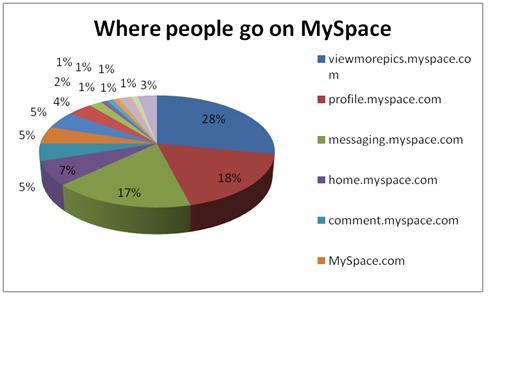
TimeLine
•MySpace was launched on August 15th,2003 by Tom Anderson, Chris DeWolfe and their small team of programmers. When MySpace was born Friendster was the superior social networking website but MySpace’s was able to take down Friendster's enormous ego by its unique interface which allowed users to customize their own profile pages.
•In 2005,Fox Interactive Media chairman Rupert Murdoch purchased Intermix Media(MySpace’s parent company ), for a reported $580 million 2006, Google signed an eye-popping $900 million advertising and search exclusivity deal with the website.
•In 2006 after a lawsuit was filed against MySpace, it decided that it would protect its members who are 14 years and 15 years olds from adults.In this features the adults can only can reach then if they knowing their email addresses or their full name.
•In January of 2006, MySpace became international.
•In August 6th,2006, MySpace officially hits 100 million users.
•On August 7th,2006, Google signed an enormous deal of $ 900 million with MySpace for exclusive advertising and searching rights on MySpace.
•In November 2008, MySpace announced that users can upload content from the media giant MTV.
•As of December 2008, MySpace has more than 250 million users and it attracts about 300 000 new user every single day.
Targeted Members
MySpace is open to ages 14 and up but 85 % of the total users are people claim to be 18 or older.
MySpace Features:
•Bulletins- the bulletins are viewable by everyone on your friends list.Although you might not want everyone to see your information but it is a good way of communicating with all your friends rather than messaging them individually.
•Groups-create or join groups of your interest.
•Status-let your friends see your plans for the day.
•Mood-your friends can see how you are feeling today.
•Blogs-just to the standard blogging or take it to the next level with photo and video blogging.
•MySpace Instant Messengers-it is similar to MSN messenger but with the MySpace IM users are notified instantly of new MySpace messages, friend requests, and comments.
•MySpaceTV-to watch YouTube and MTV videos
•Applications – over 5000 applications to capture your interest.Users can add as many applications to their profile as they wish.MySpace has special security feature which allows only friends to see the application of the user.
•MySpace Mobile- access MySpace on your cellular phone.
•MySpace News-news is displayed in RSS feed which is a family of Web feed formats used to publish works such as news headlines.It allows the user to rank their top news stories.The stories that appear on the page first are more highly ranked than those that are near the bottom of the page.
•MySpace Classifieds-search for millions of classified ads and post your own add.
•MySpace Karaoke-users can upload their recordings on their profile where thier friends judge their performances.
•MySpace polls-users can answer questions from any category and also see what their fellow users think about that topic.
•MySpace forums-talk about anything that is on your mind.
•MySpace Mobile Alerts-Short message service alerts directly on your mobile where you get new MySpace messages, friend requests, and much more.
•MySpace Horoscopes-see in depth what the future has in store with you with MySpace Horoscopes.
•MySpace Books-see which books MySpace users consier to be the top books.Also read review on many more books.
•MySpace Music- with over 5 million artist on MySpace you have to got plenty of music to choose from.You can upload a maximum of 6 songs from a single artist in a month on to your profile.
Security
MySpace's new enhanced safety features include:
•Strangers who are over the age of 18 will no longer be able to contact members under the age of 16, unless they know their email address or the first and last name of members who are the under the age of 16.
•Full Privacy Settings for All Members: All MySpace members have three options in thise cirteria.One is to set their profiles to private, giving only their only friends within their private network are to view information such as thier interests and friends.MySpace members have the option to set their profile to restrict contact to members within their own age group. The users can make thier poriflable viewable to everyone or just users 18 and over.
•Age Appropriate Ads: MySpace is trying to target advertsing based on age appropriateness. The main purpose of this is block out tabacco,alochol and adds releated to sex for minors.
•Block Users: Block individuals that you don't want them to connect you and block your personal information from being veiwed by them.
•Online: You can choose to show when you are online or let them think you are offline but you are actually online.
•Spam Filter:Customize your settings of how much spam do you want to recieve.
•Communication Settings: Choose if to allow non-friends to send you messages,event you to group and event inviations or does this ability is only possesed by your friends.If you don't like being send group or event invitations you can choose the option which will allow no one to send you invitations.
What is Facebook?
Facebook is the most popular known online social network today. Facebook was created by a Harvard University Student by the name of Mark Zuckerberg. This social network began in the month of February 2004 and was originally designed for students only attending Harvard at the time, it was a way for students to communicate and stay up to date with what was occurring in their school. With its quick interest by students within the first month over half of the student population joined Facebook. Its vast increase in visitors and urge to compete with MySpace's popularity led the founders of Facebook to quickly extend its use. Firstly, it opened to students from specific schools to take part then finally it was decided anyone with a valid email address and over the age of thirteen in September 2006 could join. In July 2007 Facebook recorded to have over 30 million users and finally in April 2008 overtook popularity from MySpace. Facebook makes its profit through a variety of advertisements and it is quite successful at this. Facebook continues to gradually become more known to people and approximately has 150,000 new members a day. Today Facebook is recognized all over the world, and is keeping everyone connected!
How to Use Facebook
Facebook is a free social network to join and allows users to easily connect with others. A Facebook member begins with creating a profile page where they include personal information or anything for that matter. It is recommended that one post's their real name, this way it is easier for friends and family to stay connected. Every user has many options on Facebook, such as the opportunity to decide who can view their information and how much of it is revealed. This is allowed through privacy settings such as having a "Limited Profile" to others. However Facebook recommends to be cautious because identity theft is always a concern. This social network was made so people who joined could become part of smaller networks and stay connected with people in the same network as them such as from school, companies, regions, etc. Members can do many things on Facebook that will keep them entertained for a very long time, such as join applications. Facebook is meant for people to put their "real" lives online, nothing made up but to actually tell the truth. Unlike other social networks where users add anyone who sends them a random friend invitation and you accept or you decorate you profile and add some false information to make yourself sound more interesting to others. That's not the purpose of Facebook, when editing your profile page you can include things like: address, work, phone number, etc. This social network is extremely easy to use, everything is straight forward and it also includes a virtual tour for those who are having trouble or would like to learn more.
Special Features
Facebook has become rapidly popular due to its unique features/applications that keep members interested and entertained. These include:
- Friends- Accept friend invitations and connect with people you know
- Wall- Post public messages, photos and videos on friends profile
- Photos- Upload albums, allow friends to be tagged in them and allow comments
- News Feed- Constant update of what friends and you are doing on Facebook
- Status- Anything you want to write, usually what you are doing, how you feel
- Events- Create and be invited to events
- Groups- Join and make your own groups
- Gifts- Send gifts to friends for $1.00
- Notes- Blog your thoughts
- Videos- Upload and be tagged in them
- Honesty Box- Anonymous messages
- Mobile- Connect to Facebook on your phone
- Pokes- Send a virtual “Poke”
- Chat- Instant communication with friends
- Ads- Post any advertisements you’d like
Why Users LOVE Facebook
- 1. Facebook is a neat and well organized social network to use. Its layout is quite simple which increases the amount of users because it is extremely easy to use and most people won’t have a problem with it.
- 2. Facebook contains great privacy settings. It allows users to choose which information is shared and how much of it. Options are in the hands of the user and no one else.
- 3. Facebook does contain advertisements but not ones that are popping up fifty times and flashing, doesn’t slow down your computer or freeze it.
- 4. Very useful when looking to connect with friends that you don’t see often. Quickly search for their name and hopefully you’ll find them. Also unlike other social networks you are connecting with REAL friends.
- 5. On Facebook people can be themselves, no need to make up false information or feel inferior to others.
- 6. Facebook makes people feel welcomed, good and part of a close friendly environment.
- 7. Extremely good pass time, and highly entertaining!
Similarities
All four of these social networking sites mentioned are free to join. Since they are all free, hundreds of users are joining each and every day. Another major similarity is their purpose. Friendster, Nexopia, Myspace, and Facebook were all created so individuals can stay connected with family, current and old friends, classmates, and co-workers. They are also great ways to meet new friends, but you have to be very cautious when doing this since there are many individuals who create an account on these websites as someone who they are not and try to learn as much about you as they can. All four of these sites have privacy settings to control who can and can not view your profile. The settings are automatically set to private so only your friends are allowed to view your profile but you are allowed to change the settings to either only your friends, or people in your network to view it. You can also block desired individuals from viewing your entire profile or certain sections of it, such as uploaded pictures. Depending on your age, if you are younger than 18, these sites wont allow anyone older than 18 to be able to view your profile unless if you are friends with them.These social networks have become the new fad and have been taking over teenagers lives. If you go into a school computer lab or to a public library or even into a business office you will most likely see the individuals on Facebook or any of these social networks.Differences
A significant difference between these social networks is their unique design formats. Friendster, Nexopia and Myspace all use html formatting when creating profiles. This allows users to be creative with the appearance of their profiles by changing the colors giving you a brief idea on what they’re personality is like. But Facebook on the other hand doesn’t allow for any user creativity. The profiles are all identically structured and are very simple to use which is what users like the most about this social network. The simplicity of Facebook allows users to be familiar with the site very quickly and there is nothing for them to struggle with unlike users of Friendster, Nexopia and Myspace do. Some individuals aren’t too familiar with what to do when they need to use html codes and this causes difficulties and depending on the individual this may be a hard format to grasp and so they will refrain from using these websites.
Facebook is known for its thousands of applications. Users are constantly adding them and sending out notifications to their friends to add the application as well. The applications are another feature of Facebook that makes it a more popular social network than the other ones mentioned. Friendster also has the application feature, but it doesn’t have as many applications as Facebook does. Instead of featuring applications, Nexopia and Myspace allow for uploading music and video streams to your profile. Myspace is well known in the pop culture and many artists have Myspace because you are able to upload music and videos to your profile.
Facebook is the only website of the four that has an instant chat. Friends are allowed to talk to each other directly through that chat rather than through messages. Facebook also has a “News Feed” which keeps users up to date with what their friends are up to, who has become friends with who, what events are going on, and also allows yours friends to know what you have changed on your profile and what applications you have added. While Friendster, Nexopia and Myspace do not provide this feature. If you wanted to know what your friends have been up to and what changes they have made to their profile you would have to go directly to their page and view it yourself.
Nexopia makes some of its profit directly from its users. It has the feature of Nexopia Plus. Nexopia Plus can only be accessed if you pay $5 a month for this feature, and in doing so you get to view your recent visitors, you are allowed to upload more pictures than normal onto your profile, which is 8. Nexopia Plus also allows you to turn off the advertisements, you also get notified of who added you as a friend, and you can also view if a friend has read your message you have sent them or not.
Individuals starting from the age of 12 and on either have a profile on one or more of these social networks yet each of the social networking sites have different target groups. Friendster’s main target group are individuals 18 and over, but there are many who have a Friendster account who are younger than this age range. Friendster now has shifted its target group and is now aimed towards individuals in Southeast Asia. In the Philippines specifically, Friendster has become extremely popular. Nexopia targets the age group of 14 and older. Not many people over the age of 19 to 20 use Nexopia anymore, they have either shifted to Myspace or Facebook. Myspace targets anyone who is 14 years of age or older. Myspace though also targets individuals who are musicians or who are fans of music artists. Myspace is a great site where individuals can post their own music for others to listen and is also a great way for artists to profit by advertising their work. Facebook is more formal and so it targets individuals in university, college and the ones in the business world. Facebook used to target people who were 18 or over, but now it targets anyone who has an email address.
Competition
Ever since the introduction of Myspace, Friendster has pretty much shifted its target group from North America to the Philippines. Since we are testing for the popularity in Canada, we know that the social networking site Friendster is not one of the popular ones in Canada even though it used to be in the past. Nexopia also seems very small and insignificant compared to Facebook and Myspace daily visits even though it was created in Canada. So within Canada, the main competition is between Facebook and Myspace.
There are many controversies between the users of the two, as to which of these two social networking sites are better. Myspace is the social networking website with the number one rank globally, but "Facebook is really big in Canada, probably the biggest social networking website used"15. As we can see from the daily visit statistics graph on the right hand side, Myspace used to be more popular than Facebook before 2005, although not by a large margin. Facebook catches up around April of this year, and is now ahead by a large lead. After Facebook overtook Myspace in this popularity “race” in April, its number of daily visits kept on rising rapidly while Myspace’s number of daily visits gradually declined as indicated by the Chart.
Users of the two large social networking sites, Facebook and Myspace, often argue over which is the better one. Many parodies were created around these arguments. Here are a few of the Cartoons we found:
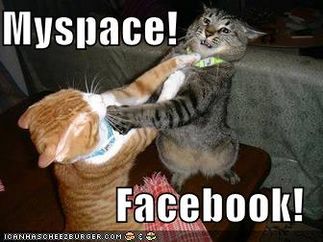
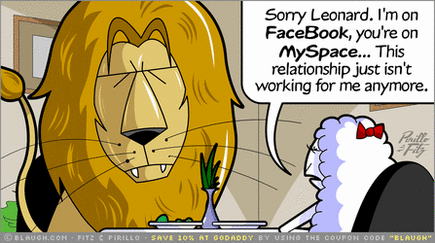
... and the winner is...
Based on the social networking trend, Facebook will “win the race” to the top, but only until a new social networking site is introduced and can get people addicted.
Bibliography
Lily Lin's references
Project Introduction
1 Dictionary.com, 2008, http://dictionary.reference.com/browse/social%20networking
2 What's in Biz, (Social Network Picture)
Friendster
3 Shozu.com (Friendster Logo)
4 Webupon, 2007 Copyright Stanza Ltd., http://www.webupon.com/Social-Networks/The-History-of-Friendster.102940
5 Blaugh.com (Patent Cartoon)
6 InvestorWords.com, 2008, WebFinance Inc., http://www.investorwords.com/3621/patent.html
7 BusinessWeek, 2008 Copyright The McGraw-Hill Companies Inc., http://www.businessweek.com/technology/content/jul2006/tc20060713_163728.htm?campaign_id=rss_null
8 Liu, L.W, Jan. 29, 2008, Time Inc.http://www.time.com/time/business/article/0,8599,1707760,00.html/
9 Comscore, 2008 ComScore, Inc. http://www.comscore.com/press/release.asp?press=2295
10 GMA News.TV, 2007, GMA Network Inc., http://www.gmanews.tv/story/104375/Friendster-to-introduce-text-alerts-in-Asia-RP
11 Manila Standard Today, 2007, http://www.manilastandardtoday.com/?page=goodLife6_mar31_2007
12 FriendsterPoint.com (Layout Image)
13 Wired, 2008, CondéNet, Inc., http://www.wired.com/culture/lifestyle/news/2004/07/64156
Competition
14 Alexa.com, (Daily visits graph)
15 Tesla Nova, 2008, http://navidadab.com/facebook-vs-myspace
16 FacebookNoticias.com, (Gun picture)
17 digitalafternoon.blogspot.com, (Cats picture)
18 blaugh.com, (Lion picture)
...and the winner is...
19 The Trifecta, (Boxing image)
Jeffrey Lu's References
Nexopia
1 StartupIndex (Nexopia Logo)
http://www.siterapture.com/sitemain.asp?SiteID=13
http://www.aboutus.org/Nexopia.com
http://en.wikipedia.org/wiki/Nexopia
http://startupindex.ca/startup/nexopia/
http://www.big-boards.com/board/856/
http://www.siterapture.com/sitemain.asp?SiteID=13
http://www.unlimitedmagazine.com/index.php?option=com_content&task=view&id=98
http://www.lycos.com/info/nexopia--timo-ewalds.html
Usman Sajid's References
Myspace
Information
- http://en.wikipedia.org/wiki/MySpace
- http://www.gnucitizen.org/blog/a-brief-history-of-myspace/
- http://personalweb.about.com/od/myspacecom/a/mysprivacyfeatu.htm
- http://techradar1.wordpress.com/2008/01/11/facebookmyspace-statistics/mashable.com/2006/08/09/myspace-hits-100-million-accounts
- http://www.marketwatch.com/news/story/comScore-Media-Metrix-Ranks-Top/story.aspx?guid=%7B208FC844-ABEB-4AC4-BFDB-B8DDD07A5ED7%7D
- http://en.wikipedia.org/wiki/List_of_social_networking_websites
- http://www.myspace.com
- http://www.answers.com/topic/myspace
- http://www.alexa.com/site/ds/top_sites?ts_mode=global&lang=none
- http://www.alexa.com/site/ds/top_sites?cc=US&ts_mode=country&lang=none
- http://www.alexa.com/site/ds/top_sites?cc=CA&ts_mode=country&lang=none
- http://www.alexa.com/data/details/main/myspace.com
- http://www.alexa.com/data/details/traffic_details/myspace.com
Pictures
Melissa Rodrigues's References
- http://mashable.com/2006/08/25/facebook-profile/
- http://www.guardian.co.uk/technology/2007/jul/25/media.newmedia
- http://www.crunchbase.com/company/facebook
- http://blog.mobilevoter.org/social-networks.html
- http://en.wikipedia.org/wiki/Facebook
- http://personalweb.about.com/od/makefriendsonfacebook/a/whatisfacebook_5.htm
- http://webworkerdaily.com/2007/07/24/12-ways-to-use-facebook-professionally/
- http://money.cnn.com/2006/10/06/magazines/fortune/fastforward_facebook.fortune/index.htm
- http://thelostjacket.com/social-media/why-facebook
- http://venturebeat.com/2008/06/13/why-facebook-is-now-the-number-one-social-network-in-the-world-and-why-this-matters/
Misel Martinovic's References
Similarities & Differences
- http://www.infernalramblings.com/articles/Entertainment/355/
- http://ebizz.wordpress.com/2007/05/23/can-facebook-win-the-battle-over-myspace/
- http://abcnews.go.com/Technology/PCWorld/story?id=3409498
- http://www.surfnetkids.com/safety/a_simple_comparison_of_myspace_and_facebook-18958.htm
- http://www.techvibes.com/blog/nexopia-launches-profile-facelift-makes-memberships-available-at-macs-stores
- http://www.myspace.com/index.cfm?fuseaction=userTour.home
- http://www.facebook.com/
- http://www.web-strategist.com/blog/2008/01/09/social-network-stats-facebook-myspace-reunion-jan-2008/
- http://www.watblog.com/2007/08/01/global-social-networking-statistics-myspace-facebo/
- http://www.readwriteweb.com/archives/social_network_faceoff.php
